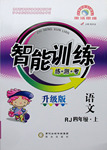题目内容
Imagine this. There's an apple and a piece of cake on a table. Which one would you like? The delicious cake or the healthy apple? A bestseller, Willpower: Rediscovering Our Greatest Strength, suggests that willpower(意志力)is the ability to make decisions that are better for us in the long term, rather than in the short term.
Here is a famous experiment in the book: The Marshmallow Test. In 1972, Professor Walter Mischel tested the willpower of 600 four-year-olds to six-year-olds. In the experiment, each child was left alone in a room for fifteen minutes with a marshmallow(棉花软糖)on a table in front of them. They were given two choices: they could either eat it or, if they waited fifteen minutes, they'd be given a second one(and then they could eat both).
So, what did the kids do? Well, as you can imagine, 70% ate the first marshmallow within the fifteen minutes. But the other 30% showed willpower—they controlled themselves and waited for the second marshmallow. But then Mischel discovered something really interesting. Twenty years later, he got in touch with the children, who, by then, were in their early twenties. And he found that those who'd shown strong willpower were getting better marks at university and were more popular.
Willpower is like a muscle(肌肉), and the more you exercise it, the stronger it gets.
So, if you do daily "self-control exercises", such as making your bed or brushing your teeth, you'll improve your overall willpower. And daily willpower exercises will help you with those bigger goals, such as studying for an exam or training for a marathon.
Be careful though. Just like any muscle, your "willpower muscle" can get tired. If you've had to do lots of things that require willpower, take a break or give yourself a treat.
That way, you’ll build up your willpower again.
And one last thing, the writer mentions people who learn foreign languages usually have a lot of willpower. So, congratulations!
1.How many children got two marshmallows in the Marshmallow Test in 1972?
A.180. B.240. C.420. D.600.
2.In Paragraphs 2&3, the famous experiment explains __________.
A.more kids have stronger willpower
B.willpower influences people's lives greatly
C.how people practice children's willpower
D.marshmallows can help improve willpower
3.The writer probably agrees that ________.
A.all the language learners have stronger willpower
B.will power can't be improved by doing some daily things
C.young kids don't need to practice willpower like grown-ups
D.people with strong willpower can achieve their goals more easily
4.According to the passage, people who ________ might have strong willpower.
A.do regular piano practice every day B.give up morning running halfway
C.eat as much junk food as they like D.usually get up late on the cold morning
 智能训练练测考系列答案
智能训练练测考系列答案假如你是李华, 最近收到外国好友Andrew的电子邮件, 请你根据该邮件内符给Andrew 回复。
Hi, Li Hua,
I’m going on holiday to your country next month with my family.
What’s the weather like at that time? I'm just planning what I need to take. What clothes do you think I need to pack? Could you tell me something about one kind of traditional Chinese art, such as paper cutting, Chinese clay art. . . ?
Thanks for your help.
Andrew
注意: (1)请回复邮件中所提及的问题, 可适当发挥;(2)邮件中不得出现真实人名和校名等相关信息; (3)词数:80~100.
To: Andrew |
From: Li Hua |
Hi, Andrew, ___________________________________________________________________________________________________________________________________________________________________________________________________________________________________________________________________________________________________________________________________________________________________________________________________________________________________________________________________________________________________________________________________________________________________________________________________________________________________________________________________________________________________________________________________________________________________________________________________________________________________________________________________________________________________________________________________________________________________________________________________________________________________________________________________ Li Hua |
阅读下面短文,完成题后的表格。
Hello, everyone! I'm Tom. This is a photo of my room. Look! This is a pencil box. It's orange. And it’s on the bed. My blue schoolbag is on the bed, too. A brown bookcase is next to the bed. Some books and a tape player are on it. The computer game is under the chair. It is black. I like black very much. My white cat is on the computer game. There is a radio on the table. I can listen to music every day.
Title(标题): 1. | ||
Things | 2. | Where |
A pencil box | Orange | On the bed |
A schoolbag | 3. | On the bed |
A bookcase | Brown | 4. |
5. | Black | Under the chair |

